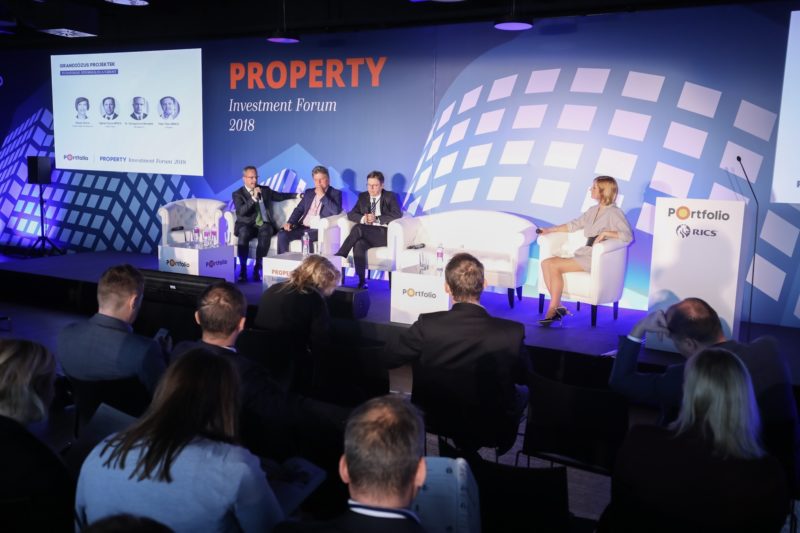The changes of the Hungarian real-estate sector, smart cities and urban development, and challenges dictated by generation Z, such as the WELL-being revolution – these were the main topics of the yearly Hungarian property market conference organised by Portfolio. Paulinyi-Reith & Partners, as on one hand pioneer in Hungarian sustainable architecture, an active participant of the ongoing urban developments of Budapest as well as an expert of urban scale developments, was present at the event.
Szilvia Bősze, the Business Development Director of P-RP led the panel on ‘Grandiose Projects'. The expert, responsible for the national and international relations and the development of new services, highlighted in her short introductory speech the social and environmental responsibility that urban scale developers have because of the volume and long term effects of such projects. As an example, she mentioned Hamburg, which is leading in increasing livability of urban areas, a city of 1.8 million inhabitants: their strategy adopted in 2014t sets a goal of turning 40% of its area into green spaces over the next 15-20 years. Owing to these provisions, Hamburg is already one of the greenest cities in Europe. The ‘Budapest 2030 - Long term urban development concept’, which was accepted in 2013 but then unworthily forgotten, is another example of urban development strategies. It outlines action plans, based on analyzes and data, for among others the increase of active green areas, the development of intermodal and other transportational connections and the improvement of energy- and climate-conscious built environment. The elaboration of the Strategy took two years with more than 50 experts working on it, among them Dr. András Reith, the Director of Sustainability at P-RP. The introduction of the moderator was followed by three urban scale projects from Budapest and a panel discussion.
The presentation of Dr. Benedek Gyorgyevics, CEO of Városliget Zrt., the company responsible for the realisation of the Liget Budapest Project, focused on the elements under construction or already completed t, such as the Museum of Fine Arts, the OMRKK (National Museum Restoration and Storage Centre), Pannon Park Biodome, the National Gallery, the Garden for the Blind People), sport courts and a dog park.
One of the most recently announced large-scale projects in Budapest, the 9 hectares so called ‘Central Park’ development next to the WestEnd shopping mall, was presented by Gyula Ágházi, the CEO of the developer Gránit Pólus Group. In addition to introducing the elements of the complex urban development project he explained the developer’s vision of establishing a green corridor along the City Park (Városliget)–Parliament and as well the St. Istvan Park–House of Terror axes. As the investment area lies in the exact intersection of the two axes, it has a great potential to become an ideal and livable hub.
Tatár Tibor, CEO of the Futureal Group has briefly presented two of the urban regeneration projects advancing in South-Buda. He talked about how Budapest ONE business complex and Etele Plaza grew into one single project based on the synergies of the area. Together with the Őrmező intermodal transit hub and the South-Buda Hospital these projects spreading over sites of different parties add up to one gigantic South-Buda City Centre urban development if coordinated well, reaching areas as far as Székesfehérvár and thus affecting over 2 million inhabitants. Futureal’s CEO is hoping that cooperation across the key players that has just started will speed up the projects.
As a moderator, Szilvia Bősze put her questions to emphasize the environmental and social awareness of the three grandiose projects. One of the most evident and effective ways to raise environmental and social potential of urban-scale projects against single building solutions is to create networks. The district heating and central cooling system that links the institutions of the City Park and the deliberate traffic network and functions were discussed. The principles of sustainability are prevailing because Városliget Zrt. is not only responsible for the development but also for the operation for a term of 99 years, which is unique compared to the practice of previous public developments.
As real estate developers, Gyula Ágházi and Tibor Tatár agreed that a livable community space is necessary for a successful urban-scale development. Both of the developer groups are willing to create public spaces bigger than the requirements in order increase popularity and thus long-term demand. According to Gyula Ágházi, the key is to keep the public park in their own operation because this is the only guarantee to maintain quality of the spaces.
Panelists agreed that there is a need for a strategical and coordinated decision making . At these gigantic investments one has to consider the aspects of traffic conditions, the social and environmental consequences of the developments, the challenges coming from generation Z, or even of connecting green areas and other parts of the infrastructure. They also find it important, that legislators and the authorities follow recent technological and lifestyle trends and their impact, like self-driving cars or the increase of remote working, decreasing the need for parking plots and change regulations accordingly.
Read the summary of the panel by Portfolio (only in Hungarian).
Prior to the conference, organiser Portfolio interviewed Paulinyi-Reith & Partners’ name giving founding partners Dr. Gergely Paulinyi, Chairman and Chief Executive Officer and Dr. András Reith, Director of Sustainability about the future of Budapest. Click here to read the full interview. (only in Hungarian)
